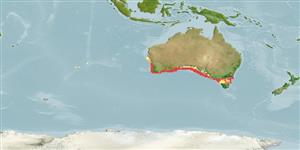Common names from other countries
Environment: milieu / climate zone / depth range / distribution range
Sinh thái học
Biển gần đáy; Mức độ sâu 70 - 490 m (Ref. 6390). Subtropical; 27°S - 41°S
Indo-Pacific: endemic to the southern waters of Australia, from Marrawah in northwestern Tasmania to latitude 27°S off Western Australia. This species has been confused with Platycephalus speculator until recently.
Length at first maturity / Bộ gần gũi / Khối lượng (Trọng lượng) / Age
Maturity: Lm 40.0, range 45 - ? cm
Max length : 70.0 cm TL con đực/không giới tính; (Ref. 6390); 94.0 cm TL (female); Khối lượng cực đại được công bố: 0.00 g; Tuổi cực đại được báo cáo: 20 các năm (Ref. 6390)
Occurs on the continental shelf and upper slope (Ref. 9563). Feeds primarily on fish, crustaceans and squid (Ref. 6390). Probably forms aggregations by sex (Ref. 27192). Sold as fresh, chilled, or frozen fillets in the domestic market.
Paxton, J.R., D.F. Hoese, G.R. Allen and J.E. Hanley, 1989. Pisces. Petromyzontidae to Carangidae. Zoological Catalogue of Australia, Vol. 7. Australian Government Publishing Service, Canberra, 665 p. (Ref. 7300)
IUCN Red List Status (Ref. 130435)
CITES (Ref. 128078)
Not Evaluated
Threat to humans
Harmless
Human uses
Các nghề cá: Tính thương mại
Thêm thông tin
Các tài liệu tham khảoNuôi trồng thủy sảnTổng quan nuôi trồng thủy sảnCác giốngDi truyềnElectrophoresesDi sảnCác bệnhChế biếnMass conversion
Các công cụ
Special reports
Download XML
Các nguồn internet
Estimates based on models
Preferred temperature (Ref.
115969): 12.7 - 15.8, mean 14.4 (based on 15 cells).
Phylogenetic diversity index (Ref.
82804): PD
50 = 0.5000 [Uniqueness, from 0.5 = low to 2.0 = high].
Bayesian length-weight: a=0.00525 (0.00246 - 0.01120), b=3.04 (2.85 - 3.23), in cm Total Length, based on LWR estimates for this (Sub)family-body shape (Ref.
93245).
Mức dinh dưỡng (Ref.
69278): 4.0 ±0.59 se; based on food items.
Thích nghi nhanh (Ref.
120179): thấp, thời gian nhân đôi của chủng quần tối thiểu là 4.5 - 14 năm (tm=4-6; tmax=20).
Fishing Vulnerability (Ref.
59153): Moderate to high vulnerability (53 of 100).
